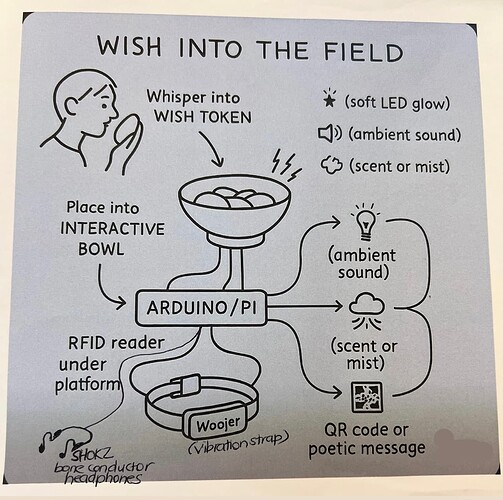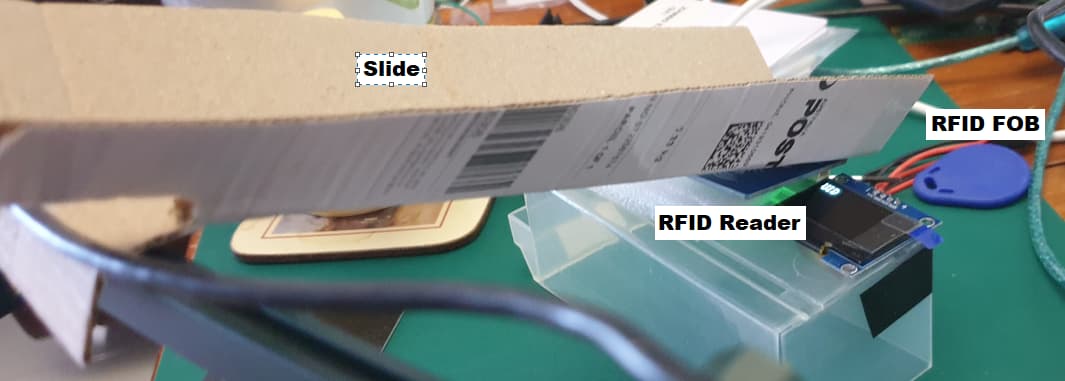Hi Core Electronics Team,
I’m Juniper, a visual artist (not an engineer, but curious and confident!) preparing a sensory interactive installation for an upcoming art event in just 9 days. I would love your help designing a simple RFID-triggered setup that can activate a light, sound, vibration, or scent when someone places a small handmade token into a bowl.
Here’s what I’m aiming to create:
 Concept:
Concept:
Each visitor whispers into a bioplastic “wish token” (which I’m making from scratch), then places it into a bowl on a plinth. This action triggers a simple sensory output — e.g. a soft LED glow, a chime, a short vibration, or mist.
 Goal:
Goal:
I just want to start with ONE trigger (e.g. light or sound) to keep it simple. If it works well, I’ll build on it for future works.
 What I think I need:
What I think I need:
I spoke with Dan, who suggested:
- x50 small RFID/NFC stickers to embed in the tokens
- PiicoDev RFID Reader Module (happy to learn and code if needed)
- A compatible microcontroller (I assume Raspberry Pi Pico or similar?)
- One output component: light / sound / vibration / scent module
- Possibly a power source or battery pack?
 My current limitations:
My current limitations:
- I’m a total beginner with hardware and code, but I can follow guides and tutorials.
- I don’t need this to connect to a smartphone — just a basic proximity-triggered response.
- I’m short on time, so I need the simplest version that works, ideally using in-stock items.
- Event is next Friday, so I’d love to buy/order what I need today.
 My Questions:
My Questions:
- What specific components would you recommend for this setup (bare minimum)?
- Is there a starter kit or project base that I can follow and adapt?
- Will the PiicoDev RFID reader work for this trigger-response model, or do I need something different?
- Do I need a breadboard, or can I solder straight to something prebuilt?
Thank you SO much for supporting creators like me — this forum is such a gift. Happy to share photos and results after the event!
Warmly,
Juniper
2 Likes
Hi @Juniper297533
Cool idea.
Good to see other artists on the forums.
To help recommend components that can be assembled in the time frame I want to understand your concept a little better.
Can you tell me more about the role of the RFID?
For example, is it only one RFID token at a time or will there be multiple RFID tokens in the plinth.
Is each Token different or contains different data?
If the role of the RFID tokens is just to detect that a new item has entered the plinth for the triggers, would you consider, given your time pressure, swapping to an easier detection mechanism? For example, a line break sensor, where the token breaks laser and deep in the plinth triggering sound or light.
Perhaps the idea is that different RFID tokens are eventually meant to trigger different events? For now your starting with one trigger, but might expand? is that right?
1 Like
The following is just some high level thoughts.
If you after a random thing, it could be based on the UID e,g, if if you have 4 outputs then based on the 2 lowest bits gives you 1 of 4 as a selector.
If you want more control then pre-registering a uid to an “output”.
You can do more complex things, but I think UID based is the simplest for this project.
My key concern is how to ensure the tag/fob/token is moved over the reader, then out of the way. While anti-collision is meant to be part of HF RFID most of the time it does not work that well, so having just 1 token in the readers field is ideal.
Also keep in mind the token needs to pass fairly closely to the reader. then move out of the way once read.
e.g. Drop token, funnels onto the reader, read the UID → take action, then some process to get the token off the reader and into the “used” bucket for re-allocation.
1 Like
After I had a play with some things last night, I think you can get this to work with a slide for the token that ensures to slides over the reader. It can detect fairly fast, but if can get the odd read error and if you need to try again the tag may be gone.
All that said, Im a little concerned with the short time frame for this project.
1 Like
Just to value add to my last post.
I run some tests this morning with an RFID Fob.
The RFID reader should be more secured and against the bottom of the slide, but this was ok.
The angle of the slide is a trade off between being steep enough for the token/fob to slide down and shallow enough to slow down the fob/token speed such that the rfid reader can get a good read.
this rough and ready setup seemed to work fairly well in my simple tests.
But its about the ideas…
1 Like
![]() Concept:
Concept:![]() Goal:
Goal:![]() What I think I need:
What I think I need:![]() My current limitations:
My current limitations:![]() My Questions:
My Questions:

